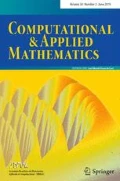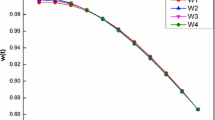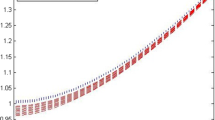Abstract
If there is a jump discontinuity present in the forcing term of a boundary value problem (BVP), the nonstandard finite difference (NSFD) and finite difference (FD) methods do not approximate the solutions very well. Here we use fuzzy transforms (FTs) and derive fuzzy transformed NSFD schemes that are referred to as non-standard fuzzy transform methods (NFTMs). The convergence of the derived NFTMs is established. Numerical solutions of Lane–Emden type equations are obtained using NFTMs. We show that NFTMs provide better results than NSFD and FD methods when the forcing term has a jump discontinuity. Even for large jumps, the NFTMs provide more accurate results than the other methods.






Similar content being viewed by others
References
Assadi R, Khuri SA, Sayfy A (2018) Numerical solution of nonlinear second order singular BVPs based on Green’s functions and fixed-point iterative schemes. Int J Appl Comput Math 4(6):134
Bede B, Rudas IJ (2011) Approximation properties of fuzzy transforms. Fuzzy Sets Syst 180(1):20–40
Berman A, Plemmons RJ (1994) Nonnegative Matrices in the Mathematical Sciences. In: Society for Industrial and Applied Mathematics (SIAM), Philadelphia
Buckmire R (2003) Investigations of nonstandard, Mickens-type, finite-difference schemes for singular boundary value problems in cylindrical or spherical coordinates. Numer Methods Part Differ Eq 19:380–398
Buckmire R (2004) Application of a Mickens finite-difference scheme to the cylindrical Bratu-Gelfand problem. Numer Methods Part Differ Eq 20:327–337
Chamber PL (1952) On the solution of the Poisson-Boltzmann equation with the application to the theory of thermal explosions. J Chem Phys 20:1795–1797
Chandrasekhar S (1967) Introduction to the study of stellar structure. Dover, New York
Chen W, Shen YH (2014) Approximate solution for a class of second-order ordinary differential equations by the fuzzy transform. J Intell Fuzzy Syst 27:73–82
Danish M, Kumar S, Kumar S (2012) A note on the solution of singular boundary value problems arising in engineering and applied sciences: Use of OHAM. Comput Chem Eng 36:57–67
Duggan R, Goodman A (1986) Pointwise bounds for a nonlinear heat conduction model of the human head. Bull Math Biol 48(2):229–236
Erdogan U, Ozis T (2011) A smart nonstandard finite difference scheme for second order nonlinear boundary value problems. J Comput Phys 230:6464–6474
Hilderbrand FB (1968) Finite difference equations and simulations. Prentice-Hall, Englewood Cliffs
Jain MK (1984) Numerical solution of differential equations. John Wiley and Sons, New York
Jain MK, Iyengar SRK, Jain RK (2012) Numerical Methods for Scientific and Engineering Computation. In: New Age International (P) Limited
Keskin AU (2019) Boundary value problems for engineers: with MATLAB solutions. Springer International Publishing, New York
Khastan A, Alijani Z, Perfilieva I (2017) Fuzzy transform to approximate solution of two-point boundary value problems. Math Methods Appl Sci 40(17):6147–6154
Khastan A, Perfilieva I, Alijani Z (2016) A new fuzzy approximation method to Cauchy problems by fuzzy transform. Fuzzy Sets Syst 288:75–95 Special Issue on F-Transform: Theoretical Aspects and Advanced Applications
Mickens RE (1981) Nonlinear Oscillations. Cambridge University Press, New York
Mickens RE (1988) Properties of finite difference models of non-linear conservative oscillators. J Sound Vib 124(1):194–198
Mickens, RE (1994) Nonstandard finite difference models of differential equations, vol 65. Singapore
Mickens RE (2000) Applications of nonstandard finite difference schemes. World Scientific, Singapore
Mickens RE (2006) A nonlinear nonstandard finite difference scheme for the linear time-dependent Schrodinger equation. J Differ Equ Appl 12(3–4):313–320
Mickens RE, Oyedeji K, Rucker S (2005) Exact finite difference scheme for second-order, linear ODEs having constant coefficients. J Sound Vib 287:1052–1056
Mickens RE, Oyedeji O, McIntyre CR (1989) A difference equation model of the Duffing equation. J Sound Vib 130:509–512
Mitchell AR, Griffiths DF (1980) Finite difference methods in partial differential equations. Wiley, New York
Obayomi AA, Oke MO (2015) A non-standard numerical approach to the solution of some second-order ordinary differential equations. Asian-Eur J Math 08(04):1550076
Pandey RK, Singh AK (2004) On the convergence of fourth order finite difference method for weakly regular singular boundary value problems. Int J Comput Math 81:227–238
Pandey RK, Verma AK (2008) Existence-uniqueness results for a class of singular boundary value problems arising in physiology. Nonlinear Anal Real World Appl 9(1):40–52
Pandey RK, Verma AK (2008) Existence-uniqueness results for a class of singular boundary value problems-ii. J Math Anal Appl 338(2):1387–1396
Pandey RK, Verma AK (2009) A note on existence-uniqueness results for a class of doubly singular boundary value problems. Nonlinear Anal Theory Methods Appl 71(7):3477–3487
Pandey RK, Verma AK (2010) Monotone method for singular BVP in the presence of upper and lower solutions. Appl Math Comput 215(11):3860–3867
Pandey RK, Verma AK (2010) On solvability of derivative dependent doubly singular boundary value problems. J Appl Math Comput 33(1):489–511
Perfilieva I (2004) Chapter 9 - fuzzy transform: Application to the reef growth problem. In: Demicco RV, Klir GJ (eds) Fuzzy Logic in Geology. Academic Press, Burlington, pp 275–300
Perfilieva I (2006) Fuzzy transforms: Theory and applications. Fuzzy Sets Syst 157(8):993–1023
Perfilieva I, Chaldeeva E (2001) Fuzzy transformation and its applications. In: Proceedings of the 4th Czech - Japan Seminar on Data Analysis and Decision Making under Uncertainity, pp 116–124
Perfilieva I, Danková M, Bede B (2011) Towards a higher degree F-transform. Fuzzy Sets Syst 180(1):3–19 Fuzzy Transform as a New Paradigm in Fuzzy Modeling
Perfilieva I, Stevuliakova P, Valasek R (2017) F-transform for numerical solution of two point boundary value problem. Iran J Fuzzy Syst 14(6):1–13
Pirabaharan P, Chandrakumar RD (2016) A computational method for solving a class of singular boundary value problems arising in science and engineering. Egypt J Basic Appl Sci 3(4):383–391
Richtmyer RD, Morton KW (1967) Difference methods for initial-value problems. Wiley-Interscience, New York
Roul P, Madduri H (2018) A new highly accurate domain decomposition optimal homotopy analysis method and its convergence for singular boundary value problems. Math Methods Appl Sci 41(16):6625–6644
Roul P, Thula K (2018) A new high-order numerical method for solving singular two-point boundary value problems. J Comput Appl Math 343:556–574
Roul P, Warbhe U (2016) New approach for solving a class of singular boundary value problem arising in various physical models. J Math Chem 54(6):1255–1285
Singh M, Verma AK (2016) An effective computational technique for a class of Lane-Emden equations. J Math Chem 54(1):231–251
Singh M, Verma AK, Agarwal RP (2019) On an iterative method for a class of 2 point and 3 point nonlinear SBVPs. J Appl Anal Comput 9(4):1–19
Tazdayte A, Allouche H (2019) Mixed method via Padé approximation and optimal cubic B-spline collocation for solving non-linear singular boundary value problems. SeMA J 76(2):383–401
Verma AK, Kayenat S (2018) On the convergence of Mickens’ type nonstandard finite difference schemes on Lane-Emden type equations. J Math Chem 56:1667–1706
Verma AK, Kayenat S, Jha GJ (2020) A note on the convergence of fuzzy transformed finite difference methods. J Appl Math Comput 1–28
Verma AK, Tiwari D (2019) Higher resolution methods based on quasilinearization and Haar wavelets on Lane-Emden equations. Int J Wavelets Multiresolut Inf Process 17(03):1950005
Xie LJ, Zhou CL, Xu S (2016) An effective numerical method to solve a class of nonlinear singular boundary value problems using improved differential transform method. SpringerPlus 5(1):1066
Yadav N, Kim JH, Yadav A (2016) Numerical solution of a class of singular boundary value problems arising in physiology based on neural networks. Adv Intell Syst Comput 437:673–681
Ziari S, Perfilieva I (2017) On the approximation properties of fuzzy transform. J Intell Fuzzy Syst 33(1):171–180
Acknowledgements
We are thankful for the time and efforts of the reviewers for such a detailed review. It has motivated us, greatly influenced the paper and raised the quality of the paper.
Author information
Authors and Affiliations
Corresponding author
Additional information
Communicated by Marcos Eduardo Valle.
Dedicated to Prof. R.E. Mickens for his work on NSFD schemes.
Publisher's Note
Springer Nature remains neutral with regard to jurisdictional claims in published maps and institutional affiliations.
Rights and permissions
About this article
Cite this article
Verma, A.K., Kayenat, S. Applications of modified Mickens-type NSFD schemes to Lane–Emden equations. Comp. Appl. Math. 39, 227 (2020). https://doi.org/10.1007/s40314-020-01257-w
Received:
Revised:
Accepted:
Published:
DOI: https://doi.org/10.1007/s40314-020-01257-w
Keywords
- Fuzzy transform
- Nonstandard finite difference scheme
- Jump discontinuity
- Convergence
- Singular boundary value problem




